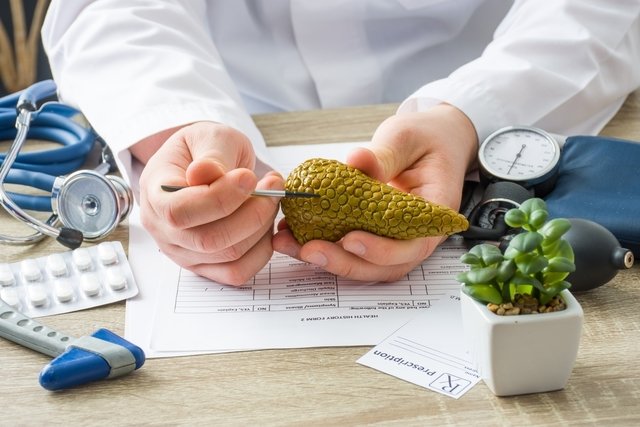Insulin is a hormone produced by the pancreas, which is responsible for transporting glucose from the blood into cells, so that it can be used as a source of energy. Insulin is mainly produced after meals, when the amount of sugar in the blood increases.
When insulin production is insufficient or absent, as in diabetes, sugar cannot be taken into the cells and, therefore, ends up accumulating in the blood and the rest of the body, causing complications such as retinopathy, kidney failure, injuries that do not heal and even favor stroke, for example.
It is important that an endocrinologist is consulted if there is a suspicion of any change related to insulin levels, as this will allow an evaluation to be carried out and blood tests to be carried out to confirm whether there is a problem related to insulin production. and, thus, being able to indicate the most appropriate treatment, if necessary.

What is insulin for?
Insulin is used to:
- Decrease the amount of circulating sugar in the blood from the digestion of food, allowing glucose to enter the body’s cells to be used as a source of energy;
- Promote glucose storage in the liverin the form of liver glycogen, and in adipose tissue in the form of triglycerides, as it helps to capture excess glucose that is in circulation;
- Regulate metabolism of carbohydrates, fats and proteins.
At the same time that insulin acts to reduce the amount of circulating sugar, there is an increase in the production of another hormone, glucagon. Glucagon has a counteracting action to insulin, so it works by releasing glucose that is stored in fat, liver and muscles into the blood, for the body to use when sugar levels are very low, such as during a period of fasting, for example. example.
The action of these 2 hormones, insulin and glucagon, is very important to balance the amount of glucose in the blood, preventing it from becoming too much or too little, as both situations bring bad complications to the body.
Types of insulin
Insulin can be synthesized to “mimic” the action of insulin naturally produced in the body, when its production is insufficient or reduced. Thus, depending on the time it takes to start its effect and the duration of its action, synthetic insulin is classified into different types, the main ones being:
- Fast-acting insulin: this type of insulin begins its effect approximately 10 to 15 minutes after its subcutaneous application, and is normally indicated to correct hyperglycemia peaks, or control blood glucose levels after eating;
- Intermediate-acting insulin: It has an onset of action approximately 1 to 2 hours after subcutaneous application, reaching a peak between 4 to 6 hours and having an effect that can last up to 12 hours, being generally indicated to control glucose levels between meals or during the night, for example;
- Slow or long-acting insulin: This type of insulin begins its effect approximately 1 and a half to 2 hours after its application, being released slowly, having a stabilizing effect on blood glucose, which can last from 20 to 40 hours, and is normally recommended for use at night, between meals or during fasting.
Furthermore, there are presentations that combine different types of insulin, to allow better control of blood glucose levels. See other types of synthetic insulin. See other types of synthetic insulin.
When do you need to take insulin?
It is necessary to use synthetic insulin in situations where the body cannot produce it in the necessary quantities, as happens in severe type 1 diabetes or type 2 diabetes. The synthetic insulin in medicines imitates the body’s insulin secretion throughout the day, both basal and pulsatile, which is why there are several types, which differ in how quickly they act on blood glucose. Understand better when it is necessary to start using insulin.
It is important that insulin is recommended by the endocrinologist and the regimen prescribed by the doctor is followed, which may depend on the person’s health condition.
How and where to apply insulin
Injectable insulin must be applied to the fatty tissue under the skin using a syringe or special pens for this purpose, and can be administered to the abdomen, arms or muscles. See more about how to apply insulin.
In the case of an insulin pump, which is a device that is placed on the skin, it is possible to program the type of insulin to be administered, which can be either basal or pulsatile, according to each person’s needs.
Bibliography
- SHARMA, AK; et al. Insulin analogs: Glimpse on contemporary facts and future prospective. Life Sci. 219. 90-99, 2019
- PEDERSEN-BJERGAARD, U.; et al. Synthetic long-acting insulin analogs for the management of type 1 diabetes: an update. Expert Opin Pharmacother. 22. 16; 2251-2259, 2021
- HIRSCH, I. B.; et al. The Evolution of Insulin and How it Informs Therapy and Treatment Choices. Endocr Rev. 41. 5; 733-55, 2020
- SILVER, B.; et al. EADSG Guidelines: Insulin Therapy in Diabetes. Diabetes Ther. 9. 2; 449-492, 2018
- RAHMAN Saidur, et al. Role of Insulin in Health and Disease: An Update. International Journal of Molecular Sciences. 22. 12; 1-19, 2021
- CDC. Types of insulin. Available at: <https://www.cdc.gov/diabetes/spanish/basics/type-1-types-of-insulin.html>. Accessed on June 29, 2022
- AMERICAN DIABETES ASSOCIATION. Understanding Insulin Resistance. Disponível em: <https://www.diabetes.org/healthy-living/medication-treatments/insulin-resistance>. Acesso em 29 jun 2022
- PAT, James; MCFADDEN, Roger. Understanding the processes behind the regulation of blood glucose. Diabetes Knowledge. Vol.100. 56-58, 2004
- GUPTA, Anuradha; SHARMA, Malini; SHARMA, Jyoti. A Role of Insulin in different types of Diabetes. Int.J.Curr.Microbiol.App.Sci. Vol.1. 58-77, 2015

Sign up for our newsletter and stay up to date with exclusive news
that can transform your routine!
Warning: Undefined array key "title" in /home/storelat/public_html/wp-content/plugins/link-whisper-premium/templates/frontend/related-posts.php on line 12
Warning: Undefined array key "title_tag" in /home/storelat/public_html/wp-content/plugins/link-whisper-premium/templates/frontend/related-posts.php on line 13




